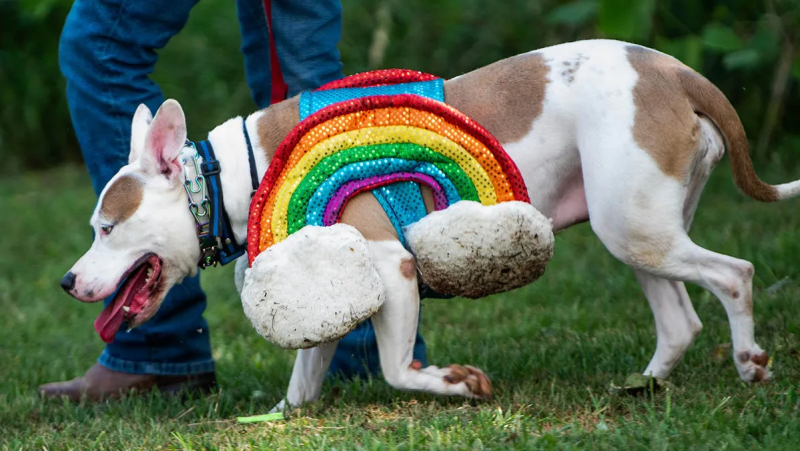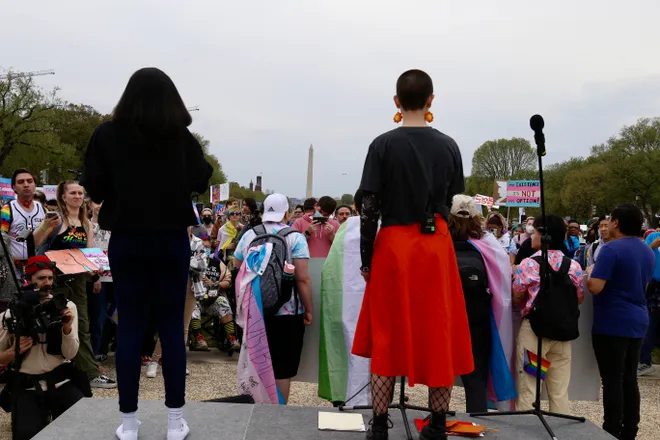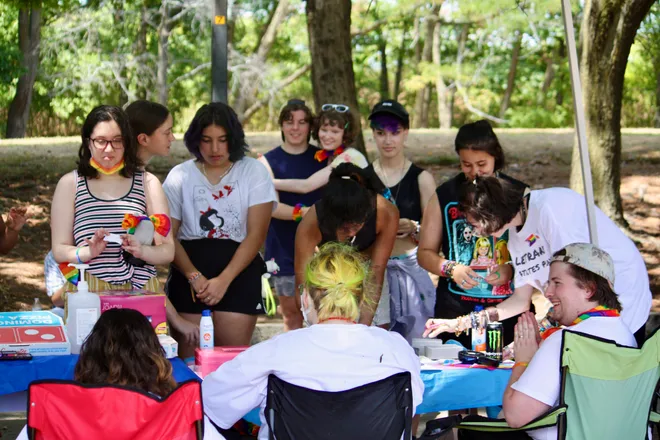'Youth are our future'? Think again. LGBTQ+ youth activism is already making an impact.
At Pride parades and protests, adults often voice a sentiment of hope for young generations: “The youth are the future.”
Forget about the future, Alyssa Wainaina would tell you – youth are doing the work right now. The 24-year-old community organizer with the non-profit Advocates for Youth has been in activism for 10 years, securing gender-neutral bathrooms in Idaho public schools, attending protests and advocating for reproductive rights and gender-affirming care. A 2022 survey from research firm Edelman found that 70% of Gen Zers are involved in a social or political cause.
“Young people have consistently been at the front of movement work,” Wainaina said. “Saying ‘youth are the future’ is … not the full story. Youth are the past and the present and the future."
But their efforts can be even more fruitful with the support of adults, said Faith Cardillo, a 19-year-old member of the nonprofit Queer Youth Assemble and the founder of Bulletproof Pride, a gun violence prevention nonprofit.
"Are we going to use our voice? Yes, should we have to by ourselves? Absolutely not," Cardillo said.
LGBTQ+ youth present and looking forward
Wainaina understands that forward-looking sentiment often comes from older activists who know how long it takes to bring about change.
But the future focus also drives long-time activists, like Cathy Renna, director of communications at the National LGBTQ+ Task Force, nuts. She finds it “a little bit insulting."
"I say that as a near-60-year-old," she said. "I can’t imagine how it makes young people feel, it’s patronizing.” She prioritizes working with young people, not because they are the "future," but because that’s “where the energy is,” she said.
Young people long been crucial to LGBTQ+ activism
With social media, Gen Z is certainly shaking up how activism is done. But that doesn’t mean youth organizing is new.
After the 1969 Stonewall uprising, the LGBTQ+ movement became less about respectability politics and more about liberation. Several youth groups emerged in the following decade.
These youth groups grew out of necessity, said Eric Denby, a history and social sciences instructor at Phillips Academy in Massachusetts. Young people were often left out of the mainstream because older LGBTQ+ activists feared being associated with minors would lead them to be labeled predators, a troubling concern historically wielded against the LGBTQ+ community. Rather than just focusing on the fight for legal rights, LGBTQ+ teenagers wanted peer-led spaces to support an array of pressing issues, addressing their housing and employment needs and providing emotional support for youth experiencing homophobia, Denby said.
In fact, many present at the Stonewall riots were young people. The legal drinking age in New York was 18 in 1969, and Stonewall had a reputation for letting in even younger patrons, Denby found in his research.
“They’ve got that energy and the naivete,” Denby said. “They haven’t been beaten down by a system that’s designed to beat them down.”
Pluto Fitch, a 17-year-old member of Queer Youth Assemble, said that energy is what makes youth activism so successful. In the past few years, Queer Youth Assemble members have hosted walkouts across the country, offered peer support and created educational materials to share on social media – all while juggling high school and college responsibilities.
“There have been so many recent bills that have been trying to shut us down and we’re not having it. We’re completely going against it and we want to be ourselves,” Fitch said. “We’ve got the energy, we mostly have the time and we want to get it fixed before we are old enough that it can’t be done anymore.”
'But most of all I'm human':Trans teens prove identity stretches beyond one label

Young people want activism to look different
In peer-led spaces, young activists don’t have to ask permission to fight for what’s important to them.
“We’re not treated as people who can be leaders,” said Queer Youth Assemble Co-President Alia Cusolito, 18. “There are very full human beings existing right now who are young and have dreams and hopes for their own lives that they want to fulfill and they should be able to do that.”

Being a young activist means thinking creatively.
“Obviously, we’ve seen that systemically, the old way doesn’t work,” Cardillo said. “Just hosting a rally once or maybe twice in a few areas that may be hubs for queer identities – that doesn’t work.”
On a video call with USA TODAY, Queer Youth Assemble members between 14 and 19 described hours-long Zoom hangouts, the thousands of TikTok comments they sorted through when organizing a national walkout and the birthday cards and postcards they sent to queer youth across the country. Only a handful of them have met in real life, but they've created a safe space online.
Social media is in part to thank for this. But that much visibility online can lead to safety concerns. Queer Youth Assemble marches and protests have received several “mass violence threats,” Cusolito said. It's not uncommon for social media discourse to lead to real-life threats. In November 2023, a USA TODAY investigation confirmed dozens of bomb threats, death threats and other harassment after popular conservative social media channels posted about LGBTQ+ events.
But the threats won't undermine their vision for the future. They prioritize lived experiences over statistics. They don’t care about aligning themselves with corporate allies who sell rainbow merch during June, Cusolito says. And young people are emphasizing intersectionality, an interconnected understanding of identity and oppression.
“Our generation is working really hard to radically decenter whiteness in our organizing work,” Wainaina said. “We focus on the most marginalized communities so that all of us can benefit.”
More than 500 anti-LGBTQ bills have been introduced in 2024, according to the American Civil Liberties Union, many of them targeting trans and nonbinary individuals. Trans people are more likely to be in poverty than their cisgender counterparts, even more likely if they are people of color.

How adults can support youth activists
The older generation can do the most for youth activists by being present, Wainaina said: “The most important thing is to be a ride or die for these youth activists.” Adults need to let young people create new ways of organizing. To let them lead and even fail on their way.
Generations working together is key to success, Denby said. Some of the longest-lasting youth groups from the 70s and 80s were peer-led but had the assistance of experienced, adult activists who could navigate bureaucracy, he explained.
“The whole world is run by adults,” Cusolito echoed. “So expecting young people to take on the burden of changing everything when they don’t let us actually have the power to do those things is completely unfair.”
It’s also the responsibility of adults to create safe spaces for queer youth as their autonomy is threatened on state and federal levels, said Kazz Alexander, a co-chair of NYC Pride. NYC Youth Pride, for example, is a free event with music, carnival games, educational resources, food, a glam tent and a wellness tent for reflective moments.
“It’s a reflection of the time that we’re in – folks are trying to remove the safety of young people under the guise of providing it,” Alexander said. “But this is actually what providing a safe space looks like.”
Disclaimer: The copyright of this article belongs to the original author. Reposting this article is solely for the purpose of information dissemination and does not constitute any investment advice. If there is any infringement, please contact us immediately. We will make corrections or deletions as necessary. Thank you.




